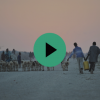
Somalia has been in the midst of an ongoing drought since 2020 that has left more than 7 million people affected. Is climate change responsible for the lack of rain?
Christophe Hodder (CH): While it is very difficult to make direct causal linkages between climate change and what is currently happening in Somalia, it is clear that extreme weather events, like droughts and flooding, are occurring more frequently. Droughts used to happen in Somalia every 10 years. But the last drought was in 2018.
How do climate change and natural resource extraction contribute to conflict and insecurity in Somalia?
CH: Increases in temperature (and) environmental degradation are increasing competition, which is leading to conflict. In Somalia, herders and farmers are often competing over grazing or agricultural lands. Stefan Döring’s research has shown how a reduction in water levels in wells has led to an increase in communal violence across Africa. In Somalia, such communal violence is leading to intra- and inter-clan conflicts and legitimizing militant groups.
Somalia has been in a civil war since 1991. How can environmental peacebuilding contribute to sustaining peace?
CH: A lot of previous interventions did not consider environmental sustainability as something that could lead to more durable peacebuilding outcomes. We need to work with military, police and maritime authorities to mainstream climate and environmental thinking to develop longer-term solutions that take into account environmental, ecosystem and human security.
Can you give us some examples of that?
CH: In Somalia, we are trialling environmental mediation. We are also looking at how to reduce natural resource destruction, such as cutting trees for charcoal, which is causing desertification, further conflict over natural resources and displacement. As well, UNEP has worked with the Food and Agriculture Organization to model and trial Nature-based Solutions.
Listen to the podcast with Christophe Hodder:
When a country mandate includes climate language: lessons from UNSOM
Can you tell us more about UNEP’s work on environmental mediation?
CH: We are trialling an approach where we bring two clans together to understand climate change [and position it] as the antagonist, rather than each other. We are trying to understand where there is competition or conflict over resources and how Nature-based Solutions can help to address this.
[For example], rather than just digging a borehole and thinking that will be it, we’re looking at the water table, the soil health in the area, and the potential for rewilding to lead to a greater area of grazing lands. We hope that these medium-to longer-term Nature-based Solutions will be the subject of a continued discussion between the clans that can hopefully lead to a reduction in conflict.
There are no formal protections under international law for climate refugees, yet climate-related displacement is a major issue in Somalia and the Horn of Africa. How can we address this?
CH: The International Organization for Migration (IOM) and UNEP did some great work with Samuel Hall on the climate and conflict displacement cycle in Somalia. It shows that while conflict-displaced populations often can move and return to their homes and livelihoods, climate-displaced often cannot return because their lands are destroyed.
At the same time, the climate-displaced often flee to urban areas, causing rapid and unplanned urbanization and issues in cities. UNEP is currently working with the IOM in Galmudug on a European Union-funded project to build resilience in communities and find sustainable alternatives to displacement.
From your experiences in Somalia, how important is it that we consider the impacts of climate change and our responses to it through a gender lens?
CH: A focus on gender is incredibly important. In Somalia, women and children make up the majority of the displaced population. Displaced women face the burden of providing for their families in extremely challenging contexts. There is also a high prevalence of sexual and gender-based violence. In addition to meeting women’s protection needs, our work should promote women’s full and meaningful inclusion in peacebuilding. It’s been shown that when women are involved in mediation and the peacebuilding processes this leads to a much more durable peace.
How do we spur global action to counter slow-onset disasters, like climate change and extreme droughts, in Somalia?
CH: I think it’s no longer a slow-onset. It’s clearly here now. We need to make the links between climate change and what is happening in Somalia. But it’s not just Somalia. Look at Sudan, the Sahel, Mali, Afghanistan. Climate change is leading to an increase in humanitarian needs.
We need to highlight how polluting developed countries is contributing to these humanitarian disasters. We need to hurry up the Paris Agreement and focus on funding green climate finance. We need to increase emergency funding to help countries, like Somalia, that struggle with access to climate financing.
This article was originally published on unep.org.
FURTHER READING
The nature of conflict and peace
New report by WWF and adelphi looks at the complex nexus between nature and security. The report outlines four pathways through which environmental degradation and biodiversity loss act as drivers of insecurity, while advancing further environmental degradation. It also provides recommendations for the UN system to work towards a comprehensive environmental security agenda.










